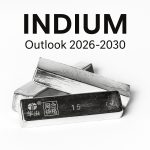
Indium’s Quiet Rally: How a Rare Metal Is Powering the Digital and Green Transition
October 14, 2025
Weekly News Review October 20 – October 26 2025
October 26, 2025China’s export restrictions on the entire rare earth supply chain continued to dominate headlines this week. While the exact impact will only become clear in the coming months, exports of these critical raw materials from the People’s Republic already fell to an annual low in September. Meanwhile, a new study underlined Germany’s firm reliance on rare earths — extending beyond industries such as automotive and machinery manufacturing.
All this and more from the editorial team at @rawmaterials.net
UNITED STATES: PENTAGON TAKES STAKE IN ANOTHER MINING COMPANY –
The Pentagon is investing in a mining project in Alaska, securing a 10 percent share in Trilogy Metals. At the same time, the U.S. government has authorized the approval of a planned access road to the remote mining area.
Making supply chains for critical minerals less dependent on China is a key priority for the current U.S. administration. In addition to accelerated permitting and research initiatives, funding and increasingly direct investments in companies are being used as tools to achieve this goal. In mid-July, the U.S. Department of Defense made headlines by taking a stake in the country’s leading rare earths company, MP Materials. In the following months, the U.S. government made additional investments in companies across the critical raw materials supply chain.
Now, another strategic investment has been announced: The mining companies Trilogy Metals, South32, and their joint venture Ambler Metals will receive nearly $36 million, again via the Pentagon, as was the case with MP Materials. Ambler Metals owns the Upper Kobuk Mineral Projects, a series of deposits in northwest Alaska containing copper, cobalt, zinc, lead, gold, and silver, among other minerals. The funds are intended to support the further development of these mining projects.
As part of the investment, the Pentagon will also acquire approximately a 10 percent stake in the Canadian company Trilogy Metals. In addition, the U.S. government has the right to purchase another 7.5 percent of the shares at a pre-set price at a later date.
Ambler Road Needed to Develop Remote Mining Area in Alaska:
According to the announcement, the three companies and the U.S. government also plan to cooperate on the permitting, financing, and construction of the Ambler Road (officially the Ambler Access Project). The planned 340-kilometer road would provide access to the remote Upper Kobuk Mineral Projects and is essential for their development.
The White House also announced on Monday that President Donald Trump has directed his administration to issue the necessary permits for the project. Despite the anticipated economic benefits for the region, the road’s construction has been controversial, reports the Anchorage Daily News. Ambler Road had previously been approved during Trump’s first term but was later blocked by his successor, Joe Biden, due to environmental concerns.
U.S. Funding for Australian Rare Earth Project Announced Simultaneously:
On Monday, the U.S. also announced additional plans to strengthen raw materials supply chains: The government-backed Export-Import Bank (EXIM) has offered the Australian mining company VHM Limited a non-binding financing package of up to $200 million. The funds are intended to support the further development of VHM’s Goschen rare earth and mineral sands project in the southeastern state of Victoria, Australia. However, China is also interested in this project: In February 2024, the Chinese rare earths company Shenghe Resources secured 60 percent of the annual production at Goschen.
CHINA’S RARE EARTH EXPORTS HIT YEAR-TO-DATE LOW:
In September, only 4,000 tons of the critical raw materials were exported — 31 percent less than in August.
China’s exports of rare earths fell sharply again in September, dropping to 4,000 tons. Compared to August, this represents a 31 percent decline, Reuters reported, citing the country’s customs data. September marks the third consecutive month of falling exports following a peak in June.
Detailed information on the development of rare earth exports — broken down by product category — will be released next week.
Last Thursday, China announced a new set of export regulations affecting large parts of the rare earth value chain, including technologies used to process these materials. In addition, several rare earth elements were newly added to the country’s export control list. As recently as April, China had imposed export restrictions on seven of the 17 rare earth elements, causing exports of some of the affected materials to drop to zero temporarily.
Whether the newly announced regulations will have a similar impact remains to be seen in the coming months. The first measures are scheduled to take effect on November 8.
ACTION DAY FOR ELECTRONIC WASTE RECYCLING:
In 2022, 62 million tonnes of electronic waste were generated worldwide, which corresponds to almost eight kilograms per person. Only slightly more than 22 percent of this material is officially recycled, according to the Global E-Waste Monitor 2024. Improper disposal is becoming an increasing problem, as waste volumes grow and potentially harmful substances enter the environment. At the same time, e-waste contains many resources that could be recovered, including materials that an increasing number of countries consider critical for the functioning of their industries.
For the WEEE Forum (Waste of Electrical and Electronic Equipment), which connects actors from the recycling industry, this is reason to mark the E-Waste Day it initiated in 2018 under the motto “Recycle your e-waste – IT’S CRITICAL.” The association aims to raise awareness that elements such as cobalt, lithium, and gallium, for example, can be recovered from electronic waste, thereby improving the supply of raw materials.
Against the background of the European Critical Raw Materials Act (CRMA), this issue is gaining significance, as the law stipulates that recycling must cover 25 percent of the demand for specific resources by 2030. To achieve this, not only is the industry called upon to develop new technologies, but also consumers. Countless unused electronic devices sit in drawers or storage rooms, making their valuable materials unavailable for recovery. According to BITKOM, the German association for the information and telecommunications industry, people in Germany alone are “hoarding” 195 million old mobile phones.
EUROPE: ONE MILLION JOBS IN GERMANY DEPEND ON RARE EARTHS –
Another three million jobs are indirectly linked to critical raw materials, according to a McKinsey analysis. In addition to increased recycling and joint procurement platforms for companies, strategic stockpiling is expected to improve supply security.
From little-known elements with obscure names to a geopolitical tool: rare earths have had quite a remarkable rise over the past few decades. Just last week, China once again pushed them into global headlines. The world’s leading producer of rare earths has sharply tightened its export restrictions across the entire value chain of these critical resources. The move likely comes in response to similar U.S. measures aimed at restricting China’s access to advanced semiconductor chips.
The exact effects on supply chains will only become clear in the coming months, but the pressure on global availability is expected to increase significantly. Following China’s last round of export restrictions, introduced in April for certain rare earths, shipments of some of these elements temporarily fell to zero.
A new analysis (in German language) by consulting firm McKinsey illustrates just how much depends on elements like neodymium and terbium: around one million people in Germany work in industries that rely on these metals—such as the automotive sector, energy supply, mechanical engineering, and medical technology. Their combined annual contribution to GDP amounts to roughly €150 billion.
Nine Percent of GDP at Risk:
About three million additional jobs in sectors such as retail and hospitality are indirectly tied to rare earths, since they depend on spending by employees in manufacturing. According to McKinsey, this represents an additional value-added effect of around €220 billion. If China, by far the largest supplier of rare earths, were to fall away, roughly nine percent of Germany’s total gross domestic product would be at risk.
Other raw materials are also essential to the country’s competitiveness, the study notes. The expansion of future technologies such as AI, robotics, and nanotechnology will further increase demand for copper, lithium, and cobalt, among others.
It is no coincidence that the EU has classified numerous raw materials as critical and strategic for its economy and dedicated an entire law to securing their supply. Reducing dependency on imports has moved high up the political agenda of the bloc—yet industry representatives have repeatedly called for faster implementation and greater funding.
Securing Raw Material Supply Requires Cross-Sector Collaboration:
The McKinsey authors echo this sentiment. Strengthening raw material security, they write, requires more collaboration—across industry, academia, and finance. They propose several measures, including joint raw material purchases to increase the market power of German buyers—a mechanism recently initiated by the EU.
The report also recommends building strategic reserves at the national or European level and expanding recycling. Joint ventures between buyers or government institutions and raw material producers could reduce uncertainty and risk on both sides. More effective, though significantly more complex, would be direct investment in raw material projects. Because of the high capital requirements, this would only be feasible for huge companies, entire countries, or the EU as a whole.
The authors also suggest establishing a German or European agency for raw material security, similar to Japan’s Oil, Gas and Metals National Corporation (JOGMEC). For more than 20 years, JOGMEC has supported domestic companies financially, technologically, and strategically in securing access to resources. Japan is generally regarded as a role model for supply chain resilience and is often cited as a reference point for similar legislation in Europe.
EUROPE’S SEMICONDUCTOR SUPPLY REMAINS FRAGILE:
A survey by the digital association Bitkom shows that German companies are particularly concerned about dependencies on China and the USA.
Without semiconductor chips, a large part of our modern daily life would come to a halt. Smartphones, washing machines, data centers, cars, and much more would not function without these tiny high-tech components. The fragility of global supply chains became especially apparent during the so-called chip crisis amid the COVID-19 pandemic. Even several years later, the supply situation still appears far from secure, according to a survey (in German language) by the digital association Bitkom.
The survey found that 92 percent of companies that work intensively with semiconductors fear that the conflict between China and Taiwan could threaten supply in Germany. In addition, 62 percent have little or no trust in the USA as a supplier of semiconductor chips. The reason for these concerns is the high dependence on these two countries: in the current year, 72 percent of the surveyed German companies purchased their chips from the U.S. or plan to do so, while 63 percent cited China as a source country. Germany follows with 54 percent, Japan with 36 percent, and Taiwan with 28 percent.
67 Percent Struggle With Export or Import Restrictions:
Procurement problems such as delivery delays and price increases were reported by 96 percent and 91 percent, respectively. 67 percent face export or import restrictions. As previously reported, raw materials giant China has imposed strict export controls on several materials relevant to chip manufacturing, including gallium and germanium, as well as rare earth elements. In response to the ongoing chip shortage, the surveyed companies have primarily stockpiled chips, entered into long-term agreements with suppliers, or diversified their supply chains.
In addition to their own initiatives, they are also calling for more political support. For example, 90 percent argue that Germany must reduce one-sided dependencies in semiconductor supply. More European manufacturing capacity and strategic partnerships are needed for this, explains Bitkom President Dr. Ralf Wintergerst. To strengthen the entire value chain, fiscal and policy incentives, reliable regulatory conditions, and reduced bureaucracy could all contribute.
EU Measures to Strengthen the Domestic Chip Industry Under Criticism:
These are the improvement measures that the EU had already announced in 2022 with its Chips Act. The legislation aims to achieve a 20 percent share of global chip production by 2030. However, the plan—and especially its implementation—has repeatedly faced criticism, including from the European Court of Auditors. Recently, the Semicon Coalition, an EU-wide initiative to strengthen the domestic semiconductor industry, also judged the targets as unrealistic and called for a revision of the Chips Act.
Meanwhile, in Germany, the planned construction of semiconductor factories by the U.S. companies Intel and Wolfspeed, which were supposed to benefit from subsidies from both countries, has been canceled or postponed. Reasons cited include the difficult market situation, economic risks, and growing geopolitical challenges.
UNITED KINGDOM: PENSANA TO MOVE UK RARE EARTH REFINERY PLANS TO THE USA –
The British mining company Pensana will not move forward with building its domestic rare earth refinery, according to media reports. The planned plant in Hull, Northeast England, was intended to process raw materials into oxides. Currently, there are only a few facilities outside China capable of performing this stage of the value chain.
Due to more favorable market conditions, the processing activities are now set to be relocated to the U.S., said founder and chairman Paul Atherley in an interview with Sky News, which first reported the plans. He specifically cited the Pentagon’s involvement with the most significant U.S. rare earth producer, including a supply agreement with a guaranteed minimum price, which he said repriced the market. Atherley expects further similar deals in the U.S. and criticized what he sees as insufficient government support for the industry in Europe and the UK.
The previous UK government had announced investments in the Hull refinery as part of its critical minerals strategy. According to Sky News, however, the funding was never disbursed because the plant was not realized, despite the groundbreaking in summer 2021.
Pensana’s Longonjo rare earth mine in Angola appears to have progressed significantly further. According to the company (PDF), production is scheduled to start in 2027, and much of the financing for the first phase of construction is already in place. Part of the raw material for the planned Hull plant was to come from Longonjo. The rare earths mined there could now instead be processed in India and the U.S. In June, Pensana signed two corresponding memoranda of understanding.






